Key takeaways:
- The evolution of vintage toys reflects societal and technological changes, with a shift from handcrafted items to mass production in the early 20th century.
- Classic toys like Tonka trucks promote imaginative play and problem-solving, offering a tangible connection to childhood amid today’s screen-dominated environment.
- Tonka trucks are known for their durability and detailed design, facilitating creative play and building lasting childhood memories.
- Caring for vintage Tonka trucks involves proper cleaning, storage, and regular inspections to preserve their charm and connection to the past.
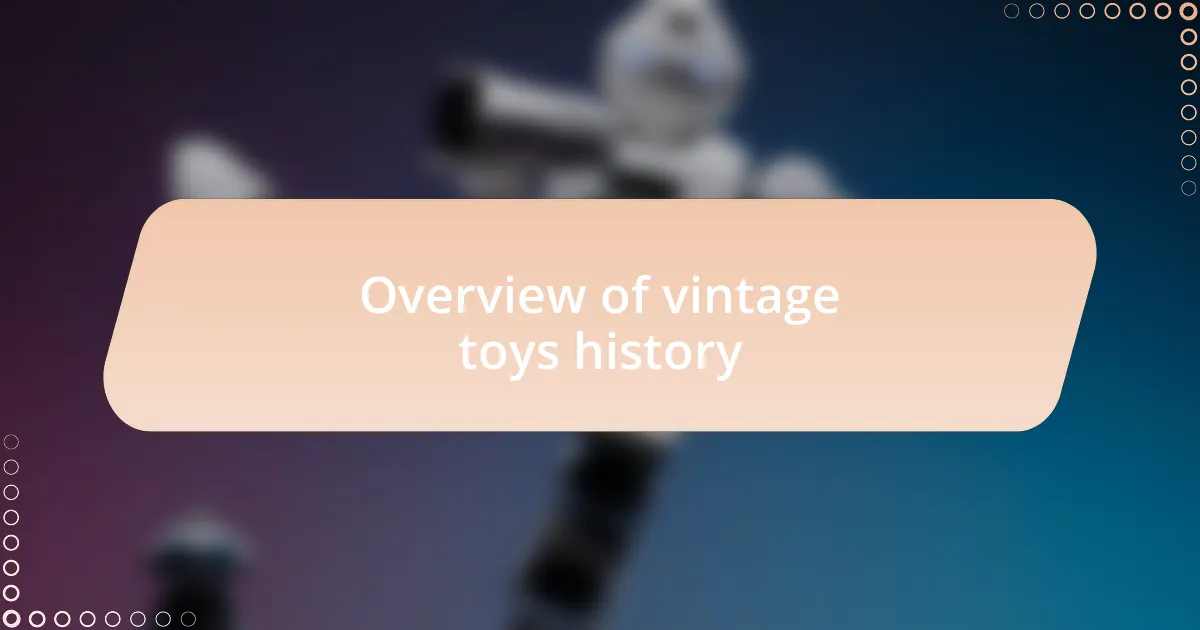
Overview of vintage toys history
The history of vintage toys is a fascinating journey through time, reflecting societal changes and technological advancements. I reminisce about exploring my grandmother’s attic where I discovered a box of wooden toys, each with its own unique story. It makes me wonder how many children played with those same toys, creating cherished memories long before the digital era took over our playtime.
In the early 20th century, toys began to shift from handcrafted items to mass-produced goods, which made them accessible to a broader audience. I remember being captivated by the metal friction-powered cars and colorful blocks that filled the playroom during my childhood. How did those simple designs inspire endless hours of imaginative play for generations?
By the 1950s, the toy industry exploded, introducing iconic brands and products like Barbie and Lego. The sheer thought of how those toys affected play patterns is striking. Did you ever consider how a single toy can become a rite of passage for children, shaping their creativity and social skills? It’s a testament to the powerful role vintage toys play in our nostalgic reflections of childhood.
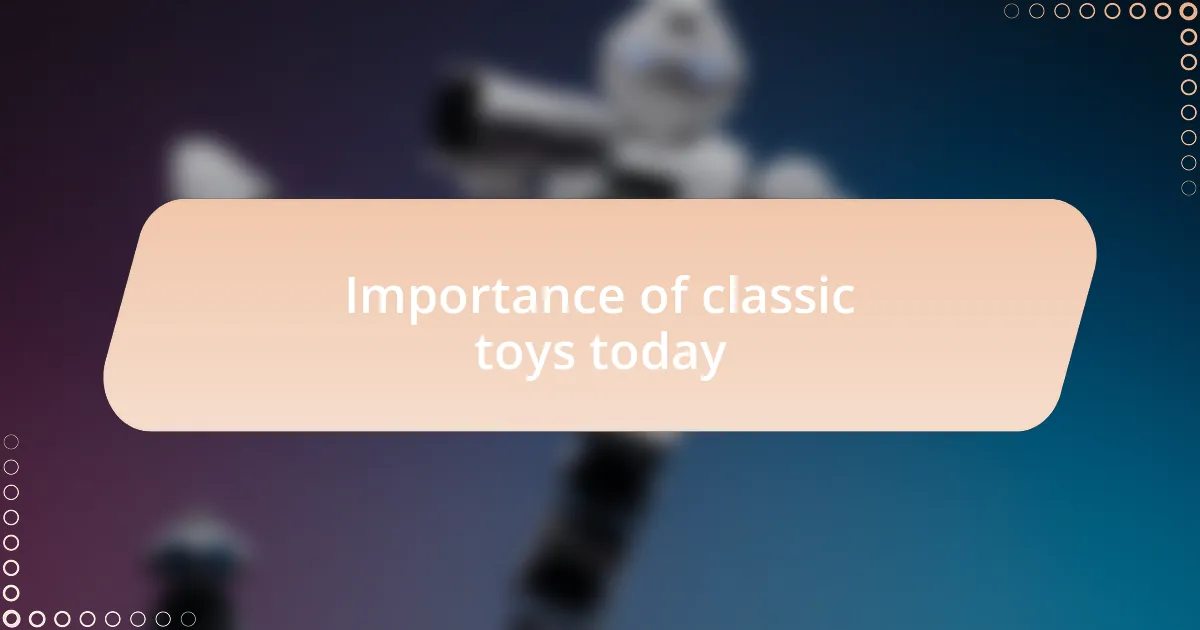
Importance of classic toys today
Classic toys hold a significant place in today’s world, offering a tangible connection to simpler times. I often think back to the hours spent building makeshift roads for my Tonka trucks, feeling the satisfaction of creating my own adventures. Isn’t it remarkable how these toys encourage problem-solving and imaginative play, nurturing skills that are as relevant now as they were decades ago?
In an era dominated by screens, classic toys serve as a reminder of the importance of hands-on experiences. I remember the tactile joy of rolling a Tonka truck across the floor, feeling the weight and solidity of it in my hands. It’s a stark contrast to today’s virtual distractions; these toys promote interaction and creativity that screen time often lacks, engaging children in active rather than passive play.
Moreover, classic toys foster connections—between generations and within families. I cherish the moments when I introduced my own children to the Tonka trucks from my childhood, watching their eyes light up with curiosity. Isn’t it interesting how sharing these toys transcends time, creating a shared language of play that strengthens bonds? These experiences remind us that, while technology evolves, the essence of play remains timeless.
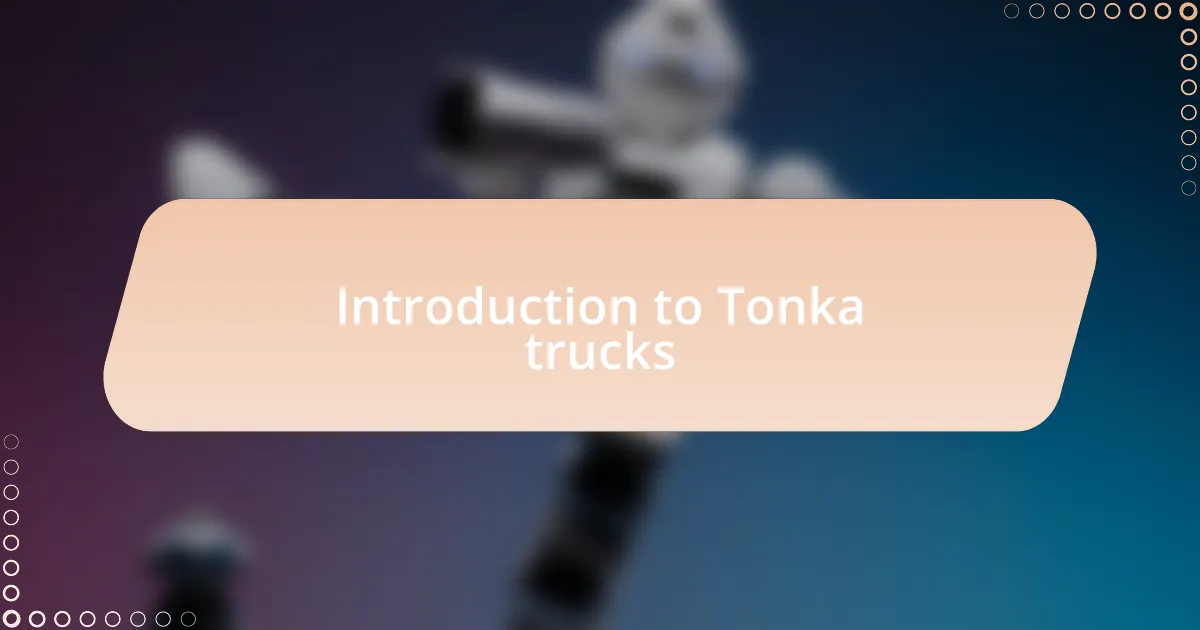
Introduction to Tonka trucks
Tonka trucks have been a beloved toy for generations, known for their durability and iconic design. I can still recall the first time I laid eyes on one; its shiny, yellow exterior instantly caught my attention. There was something undeniably appealing about a toy that looked and felt like a real construction vehicle, sparking my imagination right away.
The simple yet robust construction of Tonka trucks has made them a staple in many childhoods. I remember how my friends and I would eagerly gather in the backyard, transforming it into a construction site where we could dig, dump, and build for hours. These trucks offered not just a means of play, but a canvas for creativity, allowing us to craft stories and adventures with every load we transported.
Tonka trucks symbolize much more than just toys; they represent a rite of passage into the world of imaginative play. I often wonder how many childhood friendships were forged over the shared experience of racing these trucks down gravel paths. It’s fascinating to think how a simple toy can lay the foundation for countless memories and life lessons, don’t you think?
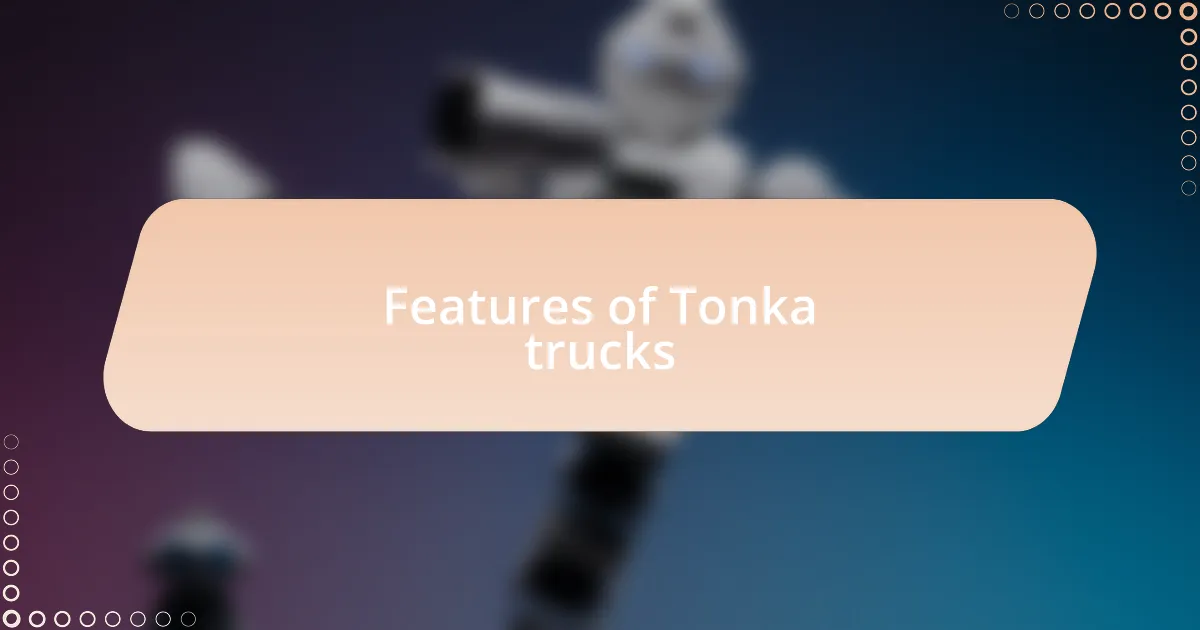
Features of Tonka trucks
The standout feature of Tonka trucks is their exceptional durability. Built tough with heavy-gauge steel, these trucks can withstand the roughest play, which is something I truly appreciated as a child. I distinctly remember my Tonka truck tumbling down a steep hill, only to emerge with a few scratches but still ready for action—talk about a resilient toy!
Another defining feature is the attention to detail in their design. Each truck is meticulously crafted to resemble real construction vehicles, complete with movable parts like the dump bed or the working crane. I recall marveling at how my friends and I would mimic real-life construction scenarios, often getting lost in the authenticity that these intricate designs offered. Didn’t it feel like we were mini-operators, commanding our own construction zones?
Tonka trucks also invite endless customization, which I found particularly thrilling. Many children personalize their trucks with paint or stickers, adding a unique flair to their beloved vehicles. I remember taking my truck and drawing on it with markers, making it feel like my very own. It made me wonder—how many others have a similar story of turning a standardized toy into a personal treasure?

Personal experiences with Tonka trucks
As a child, my Tonka truck wasn’t just a toy; it was my trusted companion on countless adventures. I remember building elaborate sandcastles and using my truck to transport “construction materials” from one end of the yard to the other, feeling a sense of purpose with every scoop of sand. Did any other kids feel that thrill of accomplishment when their trucks completed a grand project?
One vivid memory that stands out is a rainy afternoon spent indoors, turning my living room into a makeshift construction site. With pillows as mountains and blankets as roads, I used my Tonka truck to navigate the treacherous terrain. The sound of its metal wheels clattering against the floor echoed, amplifying the excitement—I can still hear the playful chaos of that day. How many of us created miniature worlds where our imaginations transformed simple toys into epic adventures?
Reflecting on those moments, I realize that Tonka trucks taught me valuable lessons about creativity and resilience. They weren’t just tools for play; they sparked my imagination and taught me how to build, both in play and in life. Looking back, I can’t help but ask—did those little metal vehicles inspire your creativity as they did mine?
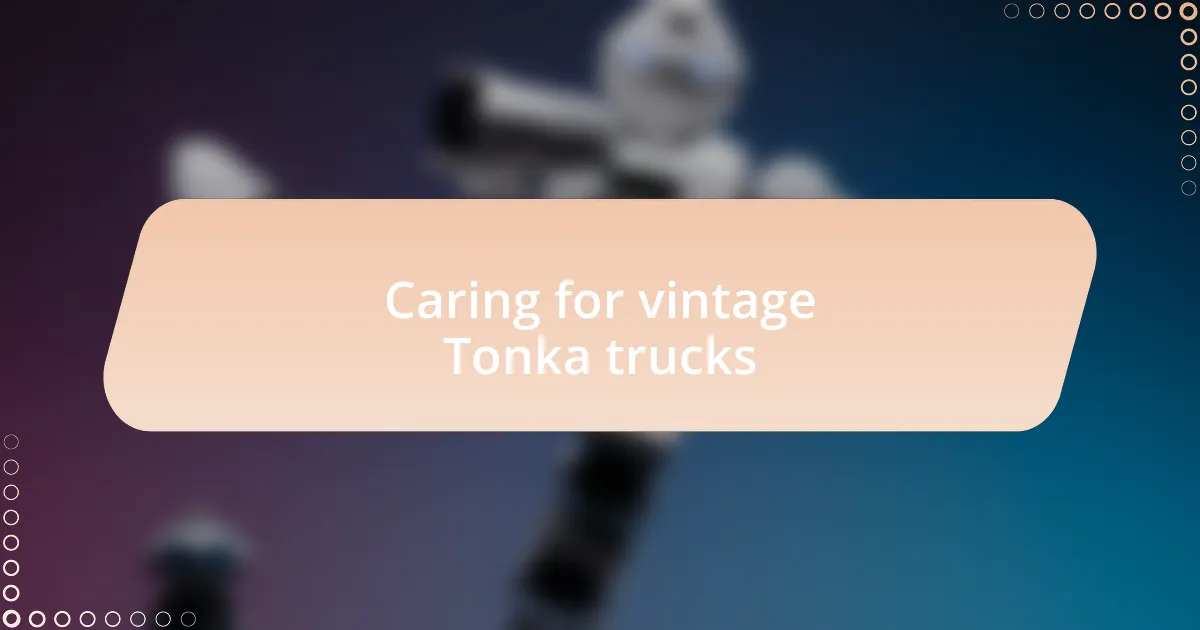
Caring for vintage Tonka trucks
Caring for vintage Tonka trucks is essential if you want to preserve their charm and value. I recall a time when I found an old Tonka truck at a garage sale, its paint scratched but its spirit intact. Proper cleaning with a soft cloth and mild detergent brought back that nostalgic shine, reminding me that a little care can go a long way in reviving a beloved toy.
When it comes to storage, keeping vintage Tonka trucks out of direct sunlight and extreme temperatures is crucial. I learned this lesson the hard way when my first truck faded after being left on a windowsill. It’s best to keep them in a cool, dry place or display them on a shelf where they can be appreciated but also protected.
Regular inspections for rust and wear can help keep your trucks in top shape. If you spot any rust developing, gently scrubbing it with fine steel wool can do wonders. Have you ever caught a glimpse of your prized toy in need of a little TLC? That simple act of restoration not only increases its durability but also deepens the connection to our childhood memories and the adventures we once embarked on together.